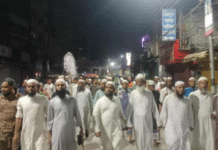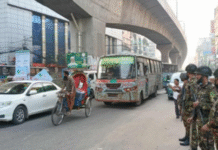Leather industry sinks, govt yet to complete industrial park in 16 yrs
 The drastic fall of leather export earnings and rawhide price during this Eid-ul-Azha is the outcome of the government’s failure of setting up an industrial park even after 16 years.
The drastic fall of leather export earnings and rawhide price during this Eid-ul-Azha is the outcome of the government’s failure of setting up an industrial park even after 16 years.
Initiated in 2003, the 200-acre park in Savar is yet to complete the Central Effluent Treatment Plant (CETP) while the work of its dumping yard has not yet begun. The authorities have also failed to hand over the deeds of the land pieces to a single tanner till now, documents suggest.
Leather industry’s stakeholders said the prices of rawhide have been low for the past three years.
This year, they added, the prices have hit the rock bottom.
About the industrial park, Dhaka University’s development studies’ teacher Abu Yusuf said there is a ‘lack of foresight in building the leather industrial park.’
As per the tradition, the tannery owners usually pay dues to the rawhide merchants during Eid-ul-Azha. They then buy the rawhide and supply to the tanners.
The tannery owners said, as the amount of export money dipped and they could not manage enough loans from the banks, they failed to provide enough money to the merchants.
During this Eid-ul-Azha, people were seen throwing rawhides on the streets as they failed to get fair prices. Despite the fact, Bangladesh imported processed leather worth nearly Tk 9.45 billion in fiscal 2018-19 from abroad.
Recognised foreign brands do not purchase goods made of Bangladeshi leather as the country’s industrial park is not environment-friendly. So, local footwear manufacturers like Apex import leather and make goods with them.
“If the leather industry had been environment-friendly, we could have exported domestic rawhides to Europe and America. We could even use leather in our factories. But, we can’t,” said Apex Footwear’s deputy managing director Abdul Momen Bhuiyan.
Just three years back, local factories used to export leather goods to European markets. But, an International Non-government Organization (INGO), Momen added, wrote a letter to the buyers alleging environmental pollution and it brought an end to the use of domestic leather.
He also said China had been the top buyer of Bangladeshi rawhides. The rawhide exportation slipped further low following the US’s imposition of tariff on China.
But, he thinks, if the industrial park has been prepared, leather goods might have been exported directly from Bangladesh to the European and American markets.
 Decline in export
Decline in export
The leather industry is the country’s second largest export commodity. The estimated target of exporting leather was set for $ 5 billion by 2021 amid a sharp decline in export.
In fiscal 2018-19, the total value of rawhide export was recorded $1.02 billion, which is 6 per cent less than that of the last year. In 2016-17 financial years, the amount was $ 1.23 billion.
The tannery owners said it took a long time to start production at Savar following a sudden closure of tanneries in 2017.
Meanwhile, the owners added, many buyers of India and Japan left Bangladesh.
“China is now our sole buyer. They are taking the chance and offering very low prices,” said Maizdi Tannery director Shahidul Islam.
“We purchased 45,000 rawhides after the previous Eid-ul-Azha. Half of them are still unsold,” he added
The industrial park at a glance
On 3 October 1951, the government shifted the leather industry from Narayanganj to Hazaribag. As the authorities failed to develop any waste refinery treatment system there, nearly 24,000 cubic metre tannery wastes were flown into Buriganga river.
Documents say the government launched a project to build a Leather Industrial Park in Savar for an estimated cost of Tk 1.76 billion. Later, the cost was lifted to 10.79 billion. The work order for waste treatment plant was issued on 11 March 2012.
Following a High Court order, the tanneries were shifted from the Dhaka’s Hazaribagh to Savar.
A total of 158 tanneries were given land. Of them, 124 tanneries have already started their operations.
In a visit, the reporters saw that the solid waste is being dumped into a nearby pond.
Bangladesh Tannery Association’s (BTA) general secretary Md Shakhawat Ullah said the crisis will not crop up if the progress made in the past six months was achieved earlier.
Asked about the Bangladesh Small and Cottage Industries Corporation’s (BSCIC) responsibility for the delay, its chairman Md Moshtaq Hasan said the BSCIC was responsible.
Many along with the BSCIC showed their negligence as land requisition took a long time despite the project’s inception in 2003.
The waste treatment plant will launch in full-fledged in December next, the BSCIC chairman said adding that the deed of the land will be handed over once the prices of the land pieces are paid.
Dhaka University teacher Abu Yusuf also said a small organisation like BSCIC may not have the capacity to build such a big industrial park.
On the other hand, he added, futuristic thinking is missing in building CETP as the plant has a capacity of refining waste of 25 cubic metres.
“Once the industrial park goes into operation, it may produce waste of 38,000 cubic metres,” he added.
*This report appeared in the print edition of Prothom Alo and has been rewritten in English by Toriqul Islam









